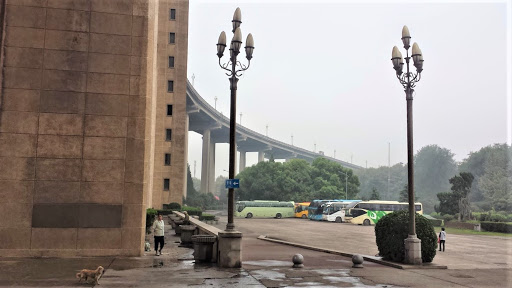When we think of Nanjing, Nanjing Massacre is the first thing that comes to mind. Unfortunately, we were not able to visit the Nanjing Massacres Memorial. It was said that many visitors after seeing the heart wrenching display were nauseated or even traumatized. Because of this, the authority decided against allowing visitors to visit this place. Whether this is true or otherwise, I just cannot be sure!
For our dinner and night excursion, we were taken to Gu Qin Huai (古秦淮) which is also known as Fu Zi Miao (夫子庙) in Nanjing. Fu Zi Miao is a famous Pedestrian Precinct in Nanjing. We were given the freedom to savor food of our choice in the many food outlets in this Precinct. This area is a favourite spot for entertainment, shopping, dining and drinking. Fu Zi Miao is situated by the Qin Huai River. Fu Zi Miao means "Confucius temple" in Chinese. The Precinct was named as such because there is a Confucius temple at one end of the street.




***************************************************
The statute of a student sitting for an examination in the Precinct reminded all visitors of Nanjing's past as the production house of scholars and bureaucrats to serve the government of the day. Nanjing was at one time the official Imperial Examination Centre for the Jiangnan region during the Ming and Qing Dynasties. The exam centre built in 1169 became the largest exam hall with over 20,000 cells for examinees. Today, a few rooms have been restored into a museum. Visitors can re-enact part of the examination process by donning the robes of Ming dynasty hat and sequestering themselves in the cells.
An old photo showing the massive exam centre with over 20,000 cells for examinees.
***************************************************
Sight seeing in Nanjing turned out to be a technical tour to a bridge - Nanjing Yangtze River Bridge. Of all the bridges in China, the Chinese are keen to showcase this particular bridge built in the 1960's. This is a a double-decked road rail truss bridge.
Communist China, after years of economic difficulties and the aftermath of the "Great Leap Forward", needed the construction of this bridge to showcase China's independence and the ingenuity of the Chinese people as propagated by Mao. According to propaganda, ordinary workers took over from the engineers and designed the bridge themselves, guided solely by Mao Zedong Thought.
This bridge is also infamous for being the most common site for suicide in the world. Over 2,000 people jumped to their death from this bridge over 38 years from 1968 to 2006. That is an average of one death per week! Life is indeed tough in China!


*****************************************************
With the statute of Mao Zedong prominently displayed at the entrance hall, the guide told the story of the celebrated swim of Mao Zedong in 1966 across Yangtze River at the age of 73. On 16 July 1966, accompanied by 5,000 young swimmers at the annual race across the Yangtze River at Wuhan, Mao was reported to have swam 15 Km in 65 minutes. The message of the swim was clear, even at 70's, Mao was still a force to be reckoned with!






the examination centres reminds of the Parrish museum in NY.
ReplyDeletehttp://www.archdaily.com/294936/parrish-art-museum-herzog-de-meuron-2/
sam